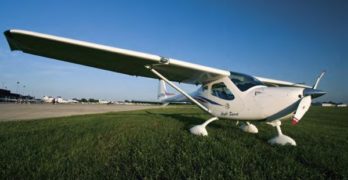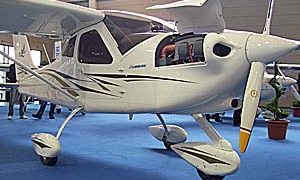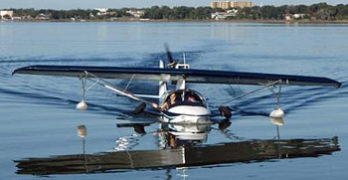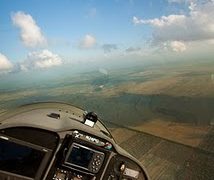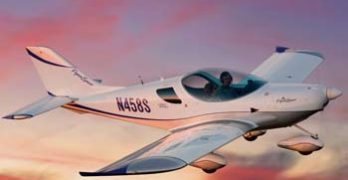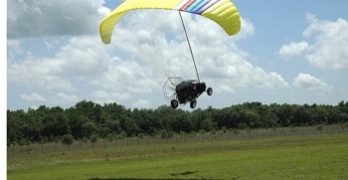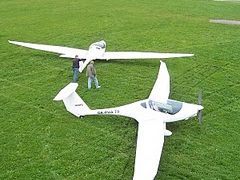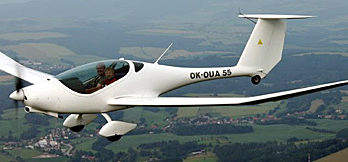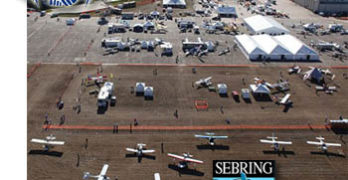At the recently concluded Midwest LSA Expo in Mt. Vernon, Illinois, SportairUSA boss Bill Canino and American Legend rep’ Dave Graham confirmed the continuation of a successful series called the LSA Tour. This traveling show-after-the-show concept set in motion a plan to follow airshows with a tour of several LSA manufacturers or importers. The idea is that many interested aviators cannot make the airshows for various reasons. So, as exhibitors head home they schedule a series of stops that may bring the show to your home field. *** The start of the LSA Tour followed the Sebring show in January 2011 with a series of stops in Florida. Then after the Sun ‘n Fun show, a group of vendors went to Georgia and North Carolina. Another series happened in Colorado. Now they’ll be invading Texas, specifically the Dallas-Fort Worth metroplex, an expansive aviation concentration of 50 airports within the 30 nm traffic area surrounding DFW, according to Graham.
Search Results for : Sebring Expo
Not finding exactly what you expected? Try our advanced search option.
Select a manufacturer to go straight to all our content about that manufacturer.
Select an aircraft model to go straight to all our content about that model.
Up-And-Comer… Remos GX
New Remos GX Rises
An LSA that was 10 years in
the making may aptly be
called a “mature design”
within this nascent sector
of piston aircraft. A few others
share a similarly “ripe, old” heritage,
but most are far newer than the trusty GA
models in which many of us learned the
art of flying.
Designed by engineer Lorenz Kreitmayr,
the first Remos G-3 took to the air
in 1997 (10 years before the upgraded GX
first flew). In 2008, N447RA, the first GX,
arrived in the States for the big summer
flyfest in Oshkosh, and that’s where I had
a chance to update my Remos experience
(previously earned in the G-3). Assisting
and educating me were two Remos reps:
National Technical Service Manager Cris
Ferguson and Managing Director of Sales
and Marketing Michael Meirer.
What’s The Difference?
While G-3 sold more than 250 copies,
performing well for European pilots for
years, the arrival of the U.S.
Aero: Lycoming Coming to More Light-Sport Aircraft
While the Continental O-200 engine — used in several Light-Sport Aircraft — attains Chinese ownership, Lycoming appears to be making a stronger push to enlist LSA manufacturers. *** One example at Aero 2011 was the upgraded Tecnam Eaglet, which airshow visitors could compare with either Rotax or Lycoming O-233 power. The appearance difference was significant and may test the market for preference for the European Rotax engine that powers 75% or so of all LSA versus the standard bearer Lycoming that has hauled generations of Americans through the skies. *** A major difference is the air-cooled Lycoming versus the liquid-cooled Rotax. Those big fins to cool the Lyc’ demand what one Tecnam rep’ called “power bulges.” The effect on the nose cowl surrounding the engine is dramatic and I’ll bet pilots like one or the other better… which is exactly the point. Tecnam will continue building both so you can — as Burger King puts it — “have it your way.” *** The company has also upgraded the interior of the Eaglet, launched at Sebring 2009, with a highly finished interior complete with new interior door treatments (photo).
SeaRey Sales Prove Popularity of Amphibians
Progressive Aerodyne and their popular SeaRey amphibian represent a current-day success sufficient to generate envy in most airframe sellers. Consider these results: Searey delivered 31 kits in 2010, an average 2.5 per month during a lousy year. Plus, in just three weeks since Sebring another 14 SeaRey kits have been ordered, upping the monthly average to 4.0. True those SeaReys are Experimental Amateur Built (EAB) kit models and so don’t compare directly with SLSA sales. *** In less than three years, company spokesman and sales director Darrell Lynds (formerly with SportairUSA) took the company from one kit a month to its current pace, along the way building a list of 1,700 very interested potential buyers. He says his 2011 orders are cash-in-hand and projects a solid year for the amphibious seaplane producer. This adds to a remarkably loyal following of 600 SeaRey aircraft builders. How can the central Florida manufacturer be doing so well?
A Day In The Office
Nothing like getting some air. *** Thanks to Jim Lee of Phoenix Air USA, I finally had my desire: Jim and I flew the fabulous new Phoenix LSA motorglider, with both wingtips (max span: 49 feet!) out of his home base at Melbourne International Airport, Florida, and I have to say simply this: it cured my winter blues.Or to paraphrase Renée Zellwegger, “Shut up. Just shut up. You had me at liftoff.” *** To say the Phoenix lives up to its advance billing is understatement, plain and simple: it’s a wonderful airplane for anybody who desires to have friendly Light-Sport handling (2 second roll rate, 45° to 45°), wonderful engine-off soaring performance (200 fpm sink rate), excellent and comfortable XC cruise (100 knots at 75%), comfortable, semi-reclined seats, great visibility with the sleek bubble canopy and forward rake of the cowl, beautiful lines, wonderful engine package… need I go on?I’ll let the pix do the talking for now.
Piper Drops Czech Sport Aircraft and PiperSport
In stunning news just before the Sebring LSA Expo starts, Piper Aircraft announced they will be terminating their business relationship with Czech Sport Aircraft, the Czech republic-based manufacturer of the PiperSport (previously known as the SportCruiser from initial developer Czech Aircraft Works). *** “After a year working with Czech Sport Aircraft, Piper determined that it is in our company’s best long-term interests to discontinue the business relationship…” said Piper CEO Geoffrey Berger. “Clearly, the company has a different business perspective and approach to the market than Czech Sport Aircraft,” he added. The company stated that “it became clear that Piper’s core strengths and that of Czech Sport Aircraft were mismatched.” *** This follows a year that saw Piper register more new SLSA than any other company, almost reaching their sales target announced at last year’s Sebring. (see note at bottom) “We at Piper have a close affinity with this emerging segment of the marketplace and we have great expectations for the LSA industry.
Maverick Goes Mega-Viral!
The dark horse, literally, to claim the Flying Car throne is the all-black I-Tec LSA-certified Maverick Sport. *** We’ve talked about it here a lot, and now the “airable” dune buggy seems to really be catching on with the public. *** I-Tec turned the flying car concept design on its head by designing a lightweight off-road car first: the ability to fly it was always the 2nd priority in the design phase. *** The result is a lightweight, off-road-sturdy, flying car that will — and this is straight from I-Tec’s Steve Saint — accelerate from 0-60 mph in 3.9 seconds. *** Holy flying Jaguar XKE, Batman! *** To prove it’s road chops, Steve and the I-Tec crew drove it 1,500 miles to Oshkosh last summer with the paraglider-like wing tucked into its roof pouch. *** In a preview of the 18-hour days they would face while swamped by a fascinated public at Airventure, the crew never made a fuel stop en route that took less than an hour — everybody had to know everything about the Maverick.
I Rise, Cried the Phoenix
Looking out the window at falling snow (and it’s only November 8th… Bah!), back from a two week vacation to Europe and Turkey, and mired in writing a big LSA buyer’s guide for Plane & Pilot mag, I’ve only got a few minutes to splash up some photos of what to me is a big event: the ASTM certification as an SLSA of the Phoenix motorglider! *** See Dan Johnson’s post below where you can follow his links to Jim Lee’s sites for more info on the exciting news we’ve been waiting for some time to hear. *** The Phoenix is the more-than-worthy “sequel” [by another, unrelated company] to the Lambada SLSA motorglider that turned a lot of pilots on (including me and Dan). When two breakups last year clouded its future, a lot of us were glad to hear from Jim that the Phoenix was waiting in the wings to take its place.
Stirring My Soul — Phoenix Rising
I’ve had the pleasure to fly more than 350 light airplanes of every conceivable description. Most of those experiences brought a smile to my face. A few genuinely stirred my soul. Though I started in powered aircraft I found my way to gliders and to soaring, which I freely admit is my favorite aviation challenge. To rise high above the Earth using only swirling currents of air is magical. *** An extra benefit was acquiring confidence about landing without an engine. To many power pilots, an engine-out landing is scary. But every landing in a glider involves but one approach. You know what? You get comfortable with it and now when I fly a power plane, I don’t worry as much about a loss of power. My power plane will just become a glider and I know how to handle that. *** So with great anticipation over an eventual test flight, I am delighted to announce the Phoenix was certified as SLSA #111 in August 2010.
Q: Aviation’s Big Challenge? A: Airplane Prices
David Kruger is what you might call a data-intensive fellow. A technical background gives him a keener than usual understanding of the value of research. Also an enthusiast of flying LSA, David has invested considerable study into the influence of airplane cost on the pilot population. His analysis suggests partner ownership of an airplane offers a means to confront the problem. At the Midwest LSA Expo I chatted at length with David and his wife/partner, Jaquidon. *** David’s work is revealed in his white papers on the subject. The reports are well considered and researched; AOPA and EAA have recognized the value of his work. If you share the concern about the decrease in pilots, you should read his report on the cost of airplanes and another on reaching the immense population of so-called powersports enthusiasts. Many believe that if aviation is to grow we must look outside our own tightly-knit club.
- « Previous Page
- 1
- …
- 19
- 20
- 21
- 22
- 23
- …
- 26
- Next Page »



